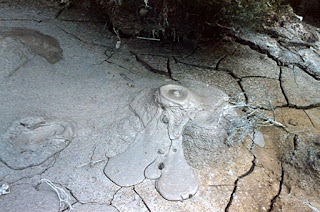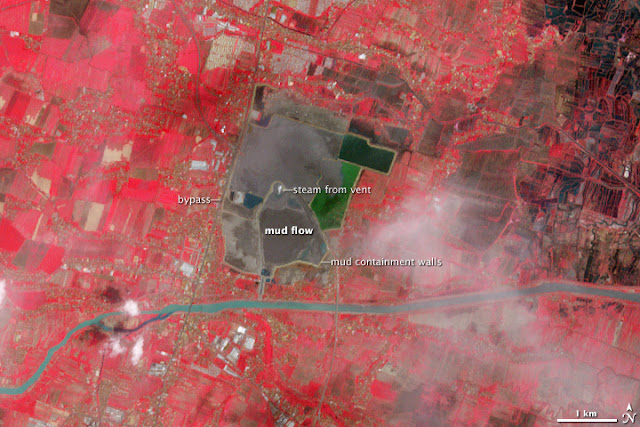As the name implies, mud volcanoes are eruptions of mud –not molten rock as in igneous volcanoes. They’re found all around the world,amounting to about a thousand in total number known. The one thing they have incommon is hot or at least warm water, so they occur in geothermal areasespecially, but they also are found in the Arctic.
They range in size from tiny, just a few meters across andhigh, to big things that can cover several square miles. In Azerbaijan some mudvolcanoes reach 200 meters, 650 feet, in height, and around the world many ofthem do have conical, volcano-like shapes. But there are others that are justlow mounds, more like a shield volcano.
 A little (15-cm) mud volcano in New Zealand.
A little (15-cm) mud volcano in New Zealand.
Photo by Richard Gibson.The mud is often enough just a slurry of suspended fine-grainedsediment that mixes with the hot water. And by hot water, we don’t necessarilymean incredibly hot – mud volcano temperatures as cold as a couple degrees Centigradeare known, but most are associated with temperatures approaching the boilingpoint of water. In some places, like Yellowstone,the water is acidic which helps it dissolve rocks down to the tiny fragments inmud, and in other places it may just be the weathered soil and debris picked upby the water that makes the mud.
Mud volcanoes can erupt violently, or seep slowly, andemissions can last from minutes to years. I think it’s fair to think of some ofthem as geysers in which the water contains a lot of sediment, while others aremore like thick, viscous muddy warm springs.
Besides water and fine sediment, mud volcanoes often containnatural gas – most commonly methane, but sometimes carbon dioxide, nitrogen, orother gases. The pressure of these gases is often the driving force behinderuptions, and with a hydrocarbon gas like methane present you might think mudvolcanoes would be associated with oil and gas fields, and you’d be right. Thehundreds of mud volcanoes in Azerbaijan and in the adjacent Caspian Sea are inthe midst of the first great oil province to be exploited, and some of the petroleumdeposits there are related to structures in the rocks and sediments caused bythe upward force of the mud, which can bend its confining rocks as it rises,just as a salt dome can do. And since methane is flammable, often enough thereare flames associated with mud volcanoes. In 2001, near Baku, Azerbaijan,flames shot 15 meters, near 50 feet, into the air. Gobustan in Azerbaijan is aWorld Heritage Site for its abundant rock carvings dating to 5000 to 20,000years ago or more. The flaming methane eruptions of mud volcanoes in Azerbaijanhave been linked to the development of the Zoroastrian religion, and in factthe name Azerbaijan derives from words meaning Land of the Eternal or SacredFire.
The most destructive mud volcano eruption in recent yearswas on the island of Java, in Indonesia, in May 2006. It erupted in the middleof a rice paddy, and ultimately killed 20 people, caused nearly 3 billiondollars in damage, and displaced 60,000 people. The mud it erupted covers aboutseven square kilometers, nearly three square miles, and in 2018 it continues toerupt something like 80,000 cubic meters of mud every day – that’s almost 3million cubic feet, 32 Olympic swimming pools each day.
What caused the violent and extensive eruption of the LusiMud Volcano, also called the Sidoarjo mud flow, on Java is not clear. It may besimply part of the ongoing natural tectonic and magmatic processes in theregion, which is dotted with many real volcanoes, the kind that carry moltenrock to the surface as lava, and there’s a fault system that may provide a conduitfor hot water from a volcano about 50 kilometers away. Lusi may be an entirelynatural phenomenon. But there are also interesting possible trigger mechanisms.One suggests that a large earthquake two days before the mud volcano eruptedchanged the plumbing system enough to spur the eruption. That’s reasonable,since we know that earthquakes can have significant effects on geyser systems.Old Faithful in Yellowstone changed its eruption period following the strong HebgenLake earthquake in 1959. The other possible trigger is nearby drilling by a gasexploration company, which may have encountered an open pocket of gas or someother feature that ultimately may have allowed enough pressure to build up tomake the mud volcano erupt. Good science on all sides of this issue have notresolved its origin with certainty, but on the whole I think the consensus isthat the mud eruption was indeed triggered by the drilling. Studies continue,and there are legal cases in progress too, of course.
 Sidoarjo Mud Flow, Indonesia, 2008NASA image created by Jesse Allen, using data from NASA/GSFC/METI/ERSDAC/JAROS, and the U.S./Japan ASTER Science Team. Caption by Michon Scott, based on interpretation by Geoffrey S. Plumlee, U.S. Geological Survey Crustal Imaging and Characterization Team. Source Another mud volcano that was recently in the news is inTaiwan. Taiwan has at least 17 mud volcanoes which have been known forcenturies, and the flammable natural gas associated with them was used inbrick-making in southern Taiwan. The gas is probably methane, and it sometimesignites naturally. The Wandan mud volcano in this area has a sporadic history,dormant for 9 years in the 1980s but erupting with damage in 2011 and 2016.Taiwan is on the subduction zone between the Philippine plate and Eurasia,complicated by a change in orientation of the subduction zone where Taiwansits. This complex tectonic setting, together with the heat liberated bysubduction, is probably the ultimate cause of the earthquakes, geologicallyrecent volcanism, and the mud volcanoes on Taiwan.
Sidoarjo Mud Flow, Indonesia, 2008NASA image created by Jesse Allen, using data from NASA/GSFC/METI/ERSDAC/JAROS, and the U.S./Japan ASTER Science Team. Caption by Michon Scott, based on interpretation by Geoffrey S. Plumlee, U.S. Geological Survey Crustal Imaging and Characterization Team. Source Another mud volcano that was recently in the news is inTaiwan. Taiwan has at least 17 mud volcanoes which have been known forcenturies, and the flammable natural gas associated with them was used inbrick-making in southern Taiwan. The gas is probably methane, and it sometimesignites naturally. The Wandan mud volcano in this area has a sporadic history,dormant for 9 years in the 1980s but erupting with damage in 2011 and 2016.Taiwan is on the subduction zone between the Philippine plate and Eurasia,complicated by a change in orientation of the subduction zone where Taiwansits. This complex tectonic setting, together with the heat liberated bysubduction, is probably the ultimate cause of the earthquakes, geologicallyrecent volcanism, and the mud volcanoes on Taiwan.
Mud volcano eruptions are probably no more predictable thanreal volcanoes or earthquakes, but their similarity to geysers might give atleast an element of predictability to them. A mud volcano that erupted inTrinidad in February 2018 seems to have a period of about 25 to 30 years, butthat’s obviously a pretty wide range. The most recent event at Trinidad’sDevils Woodyard mud volcano covered an area about 100 meters across and tossedmud six meters into the air. Like the features in Azerbaijan, the mud volcanoesin Trinidad are closely associated with hydrocarbon deposits, includingTrinidad’s famous pitch lake – thick tarry oil at the surface of the land.
Most of the hot mud activity in Yellowstone isn’t reallywhat you’d call mud volcanoes. It’s more boiling mud-rich hot springs like theFountain Paint Pots, but every now and then they can make small cones, lessthan a meter high, and in the past there have been mud-rich geyser eruptions atYellowstone.
By some estimates there are many more mud volcanoes on thesea floor than there are on land. The known offshore mud volcanoes are oftenassociated with methane hydrates – methane gas frozen into ice in the sedimentbeneath the sea floor. So it would be no surprise that as those ice-methanecomplexes melt they might drive the development of mud volcanoes underwater.
—Richard I. Gibson
Links:Trinidad
Join Podchaser to...
- Rate podcasts and episodes
- Follow podcasts and creators
- Create podcast and episode lists
- & much more
Episode Tags
Claim and edit this page to your liking.
Unlock more with Podchaser Pro
- Audience Insights
- Contact Information
- Demographics
- Charts
- Sponsor History
- and More!

- Account
- Register
- Log In
- Find Friends
- Resources
- Help Center
- Blog
- API
Podchaser is the ultimate destination for podcast data, search, and discovery. Learn More
- © 2024 Podchaser, Inc.
- Privacy Policy
- Terms of Service
- Contact Us
